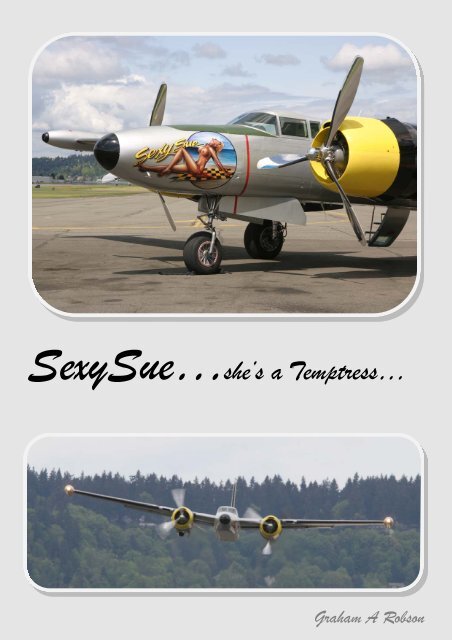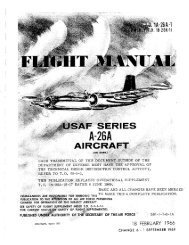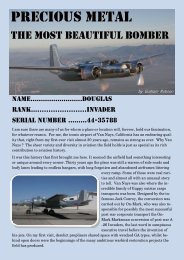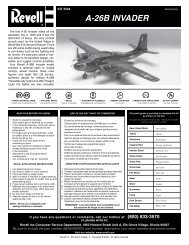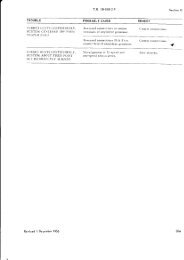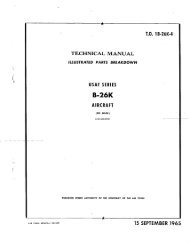You also want an ePaper? Increase the reach of your titles
YUMPU automatically turns print PDFs into web optimized ePapers that Google loves.
<strong>Sexy</strong><strong>Sue</strong>…she’s a Temptress…<br />
Graham A Robson
Well, who wouldn’t be tempted by such good looks and physique ? I too was tempted to make the journey to the<br />
far corner of the United States, at the very generous invitaon of Peter Hambling, proud owner of “<strong>Sexy</strong> <strong>Sue</strong>”.<br />
My love of the <strong>Douglas</strong> <strong>Invader</strong> and, in parcular its later incarnaon as the last word in corporate air travel, lead<br />
me to making contact with Peter to re‐acquaint myself with this parcular example, last seen in northern Minneso‐<br />
ta with a wing missing, looking sorry for herself.<br />
Peter, upon his first introducon to <strong>Sue</strong>… in his own words “succumbed to temptaon much too easily” and has<br />
been in love ever since. A childhood growing up in Yoxford, Suffolk, once the ‘back yard’ of the USAAF’s 8 th and 9 th<br />
Air Forces during World War Two and a father who was an RAF pilot, before flying for Brish Airways and Royal Bru‐<br />
nei Airlines, obviously helped mould the young Peter Hambling’s interest in aviaon. <strong>The</strong> family later moved to<br />
Seale, one of the cradles of aviaon<br />
in the USA, where Peter gained his<br />
PPL at the tender age of 16 years. He<br />
went on to study Aeronaucal Engi‐<br />
neering before moving into other<br />
areas, which later lead him into vari‐<br />
ous speciales that brought him, in<br />
1991, to start a company called Digi‐<br />
tal Control Incorporated, with busi‐<br />
ness partner John Mercer. In all this<br />
me, he never lost his interest in fly‐<br />
ing, though an <strong>Invader</strong> was a long<br />
way from his thoughts then.<br />
As with many of the marque that went on to a life in the civilian corporate world, Peter’s aircra had survived the<br />
mass war surplus scrappings because she’d been built too late for combat, her late‐coming and factory‐fresh status<br />
ensuring her survival. <strong>The</strong> fih airframe from the USAAF’s ‘block‐40’ producon batch from <strong>Douglas</strong>’s Tulsa, Okla‐<br />
homa plant in May 1945, she was given the military serial number of 44‐35562 and flown from the producon line<br />
directly to one of the War Asset Administraon’s huge storage sites awaing a potenal buyer. In the mid‐1950s,<br />
the Van Nuys, California based On‐Mark Engineering Company was proving most successful, amongst a number of<br />
lesser effecve rivals, in their civilianisaon of war surplus <strong>Invader</strong>s. Through a series of quite drasc modificaons,<br />
numerous examples of the former medium bomber were transformed into the epitome of corporate luxury travel,<br />
through a virtual re‐manufacture of their airframes. <strong>The</strong> most important change made by On‐Mark to the military<br />
model was their radical replacement of the original rear wing spar, changing out the previous carry‐through secon
with a wholly new circumferenal beam, oen called a ‘ring‐spar’, which, at a stroke, opened up the previously re‐<br />
stricted rear cabin that was the gunner’s posion in military service, into something that could offer the plaorm<br />
for a very comfortable and, ulmately, very desirable execuve airplane, the Marketeer.<br />
From this came the company’s absolute development of<br />
the marque, the On‐Mark Marksman, with an altogether<br />
higher specificaon including an even more radically re‐<br />
designed fuselage. This included pressurisaon with flat<br />
panel DC‐7 flight‐deck glazing incorporated into a wholly<br />
re‐configured fuselage that replaced the original roof<br />
structure from flight‐deck back to the fin to provide a full<br />
stand‐up passenger cabin with connuous headroom of<br />
about 6. Indeed, such was On‐Mark’s experse with<br />
<strong>Invader</strong> modificaons that they were awarded the exclu‐<br />
sive license from <strong>Douglas</strong> Aircra for the producon of<br />
spare parts for, and specilaised in the over‐hauling com‐<br />
ponents of, A‐<strong>26</strong> aircra for various operators. This included a special contract for the US military, for conversion of<br />
40 <strong>Douglas</strong> A‐<strong>26</strong> <strong>Invader</strong>s to On‐Mark B‐<strong>26</strong>K Counter <strong>Invader</strong>s, for operaon by the CIA in numerous covert acons<br />
in the early 1960s and later by the USAF in Vietnam .<br />
Like many glamorous gals over the years,’ <strong>Sue</strong>’ had a ‘nose job’ to further her career, one of her many cosmec<br />
procedures for life in the civilian world and an easy give‐away to her lineage. <strong>The</strong> extended nose conferred not just<br />
a sleeker look but also boosted the baggage storage space, improved the aerodynamics slightly and offered a suita‐<br />
ble locaon for the oponal weather‐radar. On<br />
‐Mark spared no expense in turning what was<br />
once a military tool of war into a fast, comfort‐<br />
able and efficient boardroom asset for many of<br />
America’s ‘blue‐chip’ companies, the company<br />
boasted an enviable client list indeed. Custom‐<br />
er aircra, mostly from stocks of military sur‐<br />
plus airframes, were flown into Van‐Nuys, Cali‐<br />
fornia and entered On‐Mark’s producon line<br />
housed on the NW corner of the airport. Here<br />
they underwent a virtual re‐manufacture,<br />
stripped down to bare components and re‐built<br />
to the specific requirements of the parcular<br />
client. All military equipment, if not already<br />
done so by the owner, was removed by On‐Mark and the airframe was died up with various external streamlining.<br />
Power plant opons included up‐rated engines, from the standard 2,000hp R‐2800 units right to the 2,500hp rated<br />
R‐2800 CB‐16 variants with fully reversible, broad chord propellers, which could boost cruising speed from<br />
274KTAS to an impressive 318KTAS, pung the airplane well ahead of its near rivals in the corporate world, such as<br />
Beech 18s and DC‐3s. Fuel capacity was also increased, by the addion of 165 US Gallon (625 litre) wing‐p tanks,<br />
offering a useful range of 2,600 miles.<br />
‘<strong>Sexy</strong> <strong>Sue</strong>’, always spoken of in the ‘first person’, is now well known to many in and around the Seale area. She<br />
resides in a cosy and well‐appointed hangar in the south‐eastern corner of Renton Airport and is not at all shy<br />
about showing herself, that everyone knows when she’s out and about playing ! <strong>Sue</strong> is, quite possibly, the finest<br />
example of On‐Mark’s exquisite corporate aircra sll flying today. <strong>The</strong> external clues are there to betray <strong>Sue</strong>’s<br />
former corporate life and, hidden beneath her quasi‐military exterior, is the embodiment of art‐deco corporate<br />
travel, with an un‐believably luxurious cabin and sumptuous flight deck area.
Entry into this flying palace came via a hydraulically operat‐<br />
ed integral air‐stair on the starboard side, incorporang one<br />
of the cabin windows. It was the high‐specificaon interior<br />
fit of the Marketeer that transformed the modified Invad‐<br />
er, with numerous seang arrangement opons in the new‐<br />
ly opened up cabin space provided for by the renewed rear<br />
wing spar. Extra cabin glazing was installed, with large pan‐<br />
oramic panes on both sides of the rear cabin as well as a<br />
smaller, eye level window on each side and, at lower level<br />
on the starboard side, another pair of smaller panoramic<br />
windows that allowed an unusual view below the wing in<br />
flight, from the sideways facing couch.<br />
Certain finishing touches could be added to the Marketeer customer’s specificaon, such as conference tables,<br />
reading lights, air‐vents and drinks cabinet. Whilst this all made for a very comfortable passenger cabin, it was, by<br />
today’s standards, slightly cramped and access to the flight‐deck required crawling below the forward wing spar<br />
and, even though furnished with plush deep‐pile carpeng, was sll not the most convenient or courteous way to<br />
move between flight‐deck and rear cabin. Needless to say, heavy sound‐proofing was also added as, even in the<br />
cruise, engine noise from the pair of huge 18 cylinder radials was difficult to mask.<br />
Proud owner, Peter, an experienced single engine pilot,<br />
hadn’t set out to become an A‐<strong>26</strong> owner and admits that<br />
a long‐me love of the <strong>Invader</strong> was his weakness that<br />
caused the purchase. Though he does confess that his<br />
impulsive acquision was not nearly as difficult to explain<br />
to his dear wife Lorrie, as was the raunchy artwork dis‐<br />
played proudly on the nose ! <strong>The</strong> aircra had recently<br />
undergone a thorough restoraon and refurbishment by<br />
then owner Calvin Burgess, at his restoraon shop Vin‐<br />
tage Aircra LLC., Guthrie, Oklahoma. According to Peter,<br />
once he’d decided to dip his toe in the water of the A‐<strong>26</strong><br />
owners’ pool, he was directed towards Burgess’s lovely<br />
example by mutual friend and A‐<strong>26</strong> expert Ma Jackson, who had organised for the aircra to be flown to New<br />
Mexico from its Guthrie, Oklahoma base for Peter to see and familiarise himself with.<br />
<strong>The</strong> owner, though not sure he was really commied to selling the aircra, had had it posted for sale for some me<br />
and was already in negoaon with one of its previous owners, who was actually close to concluding a deal to re‐<br />
acquire the aircra when Peter purchased it. In Peter’s words “as soon as I saw it I fell in love and made an offer
ight off the bat”. Over the following few days, under Ma’s careful tutelage, Peter began his first steps into<br />
‘warbird’ ownership and the huge learning curve in transioning to such a complex, powerful, and demanding air‐<br />
cra, as is the <strong>Invader</strong>, from his other aircra, a Cessna 206, began.<br />
Having been demobbed from the Air Force in the late 1940s, like so many other surplus <strong>Invader</strong>s, <strong>Sexy</strong> <strong>Sue</strong>’s origi‐<br />
nal history is rather obscure. Following conversion by On‐Mark to Marketeer specificaon in 1961, she was first<br />
registered to the Texas Gas Transmission Corporaon of Owensboro, Kentucky, with the appropriate markings of<br />
N707TG, with whom she was operated all across the USA unl sold in 1966. Over the following 3 years, through<br />
various registraon changes to N7079S and N9176Z she was eventually purchased by uranium exploraon compa‐<br />
ny Natrona Service Inc. and re‐registered yet again, this me as N7079G, the number she sll wears today, oper‐<br />
ang with Natrona for almost 20 years. In August 1989 she moved to South Daytona Beach, Florida and a new<br />
owner. Warbird collector Conrad Yelvington flew her for the next three years before offering the aircra for sale.<br />
Ironically, ‘79G must have made quite an impression on Yelvington, as it was he who was gazumped by Peter’s im‐<br />
pulsive purchase of it from Burgess in 2009. ‘79G then took a step into the lime‐light when sold by Yelvington to<br />
flamboyant aviatrix Lady Barbel Abela.<br />
In partnership with flying partner Len Perry, Abela had entered into the first round‐the‐world air race and was<br />
searching for a suitable mount, preferably with a ‘warbird’ background. Original plans for a Beech C‐45 Expeditor<br />
were soon shelved as un‐suitable without airframe modificaons, when the corporate Marketeer for sale in Florida<br />
was discovered. She and Perry flew out to view her and, soon realising that the aircra was both suitable, as far as<br />
range and performance, comfortable thanks to the corporate interior and of suitable ‘pedigree’, being a warme<br />
bomber, the Marketeer was purchased and ferried to Brownsville, Texas in preparaon for the race. Inspecons<br />
soon revealed a number of defects, corrosion and, more worrying, evidence of a crack in the main wing spar. <strong>The</strong><br />
expensive and me consuming repairs, together with a full re‐spray into pseudo‐military markings, boasng a suita‐<br />
ble nose‐art of ‘Bar‐Belle Bomber’ le Abela and Perry too late to enter the race, however they did cover the laer<br />
part of the course and, in doing so, achieved a number of Speed over Distance records sanconed and verified with<br />
the Naonal Aeronauc Associaon. Following the world records Perry then ferried the aircra to the USA to<br />
aend the 1992 EAA Oshkosh event from where he flew to Minnesota to take part in an airshow at Holman Field,<br />
downtown Minneapolis on August 9th. During a steeply banked turn over the field, towards the end of a display<br />
with a number of B‐25 Mitchells, Perry reported hearing a loud ‘bang’ and the airframe juddered, which brought<br />
about a swi landing and quick confirmaon that the wing spar had cracked once more. This failure of the wing<br />
spar had been an ‘Achilles heel’ for the <strong>Invader</strong>’s later life, hard manoeuvring at speed or high operang weights<br />
exerng the wing to greater stresses.<br />
Sadly, the damage to ‘Bar‐Belle Bomber’ was outside the nor‐<br />
mal wing‐spar repair opon for the <strong>Invader</strong> and she remained<br />
grounded at Holman for the next six years whilst repair opons<br />
were invesgated and work carried out. During this me of<br />
open storage, mostly with the port wing removed, ownership<br />
changed to the Combat Air Museum, of Lafayee, Louisiana,<br />
but in January 1998 local warbird collector Wally Fisk acquired<br />
the aircra for his Polar Aviaon Museum, part of his Amjet<br />
Aircra Corporaon at nearby Anoka County Airport, Minneso‐<br />
ta. Fisk’s museum enterprise was wound up in 2000 and the<br />
collecon of rare and valuable aircra disposed of, which included the, now repaired, ‘Bar‐Belle Bomber’. Enter, Mr<br />
Calvin Burgess, proprietor of a number of business ventures including Vintage Aircra LLC. Burgess had the aircra<br />
flown to his restoraon workshop in Guthrie, Oklahoma and there began the wonderful restoraon, inside and out,<br />
of what would become “<strong>Sexy</strong> <strong>Sue</strong>”, named aer his wife, although, history does not record whether the nose art to<br />
accompany the name is a faithful representaon !
Since acquiring “<strong>Sexy</strong> <strong>Sue</strong>” in 2009, Peter has not been shy about pung her in the air and, it is very likely that<br />
N7079G is one of the most frequently flown <strong>Invader</strong>s in the world. Hardly a week goes by without her taking to the<br />
sky, mostly for pleasure, “ ..I'm the proud, and lucky!, owner of N7079G. We've owned her for 2 years now and fly<br />
her all the me, oen two or three mes each week, all over the Western United States with frequent cross coun‐<br />
try trips like she loves to do. Recently, we went to Missoula, Montana with 8 souls and 2 dogs on board.” Geng<br />
used to such a powerful airplane is on‐going for Peter and his conversion to and confidence with his beauful dis‐<br />
tracon is the responsibility of Co‐Pilot and Crew Chief Brad Meeuwse, a young man with, quite possibly, the best<br />
job in the world ! Brad’s face lights up when describing his role. “I’ve known Peter for a number of years, being re‐<br />
sponsible for maintaining and oen flying his Cessna 206, both on convenonal undercarriage and now, as it is, on<br />
floats, so Peter thought of having me look aer and fly the A‐<strong>26</strong> was the natural thing.” Brad quickly began col‐<br />
lecng anything and everything that he could to establish a support programme for the aircra, which now includes<br />
a healthy spare parts stockpile, as well as trying to establish connecons with other <strong>Invader</strong> owners. In reality, un‐<br />
der Brad’s custodianship, at Aero‐Dyne Aviaon in Renton, <strong>Sue</strong>’s every wish is catered for.<br />
Peter has ambious forthcoming plans for <strong>Sue</strong>, with hopes of taking me off in the coming year to fly her around<br />
the world. “Nothing is concrete yet, but we’d like to fly her, over a number of stages, right around the world, how‐<br />
ever, certain legs will require some form of support or sponsorship, through the more restricve airspace and com‐<br />
plex local requirements of certain parts of the world, notably the middle‐East.” One can easily understand that a<br />
former American Air Force bomber, emblazoned with the disncve military Star and Bar insignia might cause cer‐<br />
tain fricons, however, Peter chuckles “it is not her military markings that will be the concern, but the big breasted,<br />
naked lady displayed on the nose !”.
We await further news and look forward to, hopefully, seeing <strong>Sue</strong> passing through the UK on her extended vaca‐<br />
on someme in the near future.<br />
© Graham Robson June 2012


